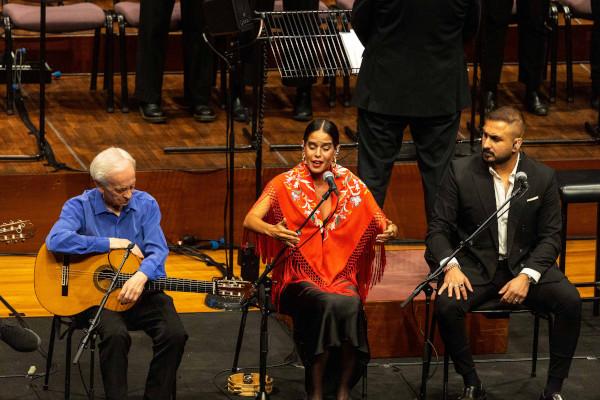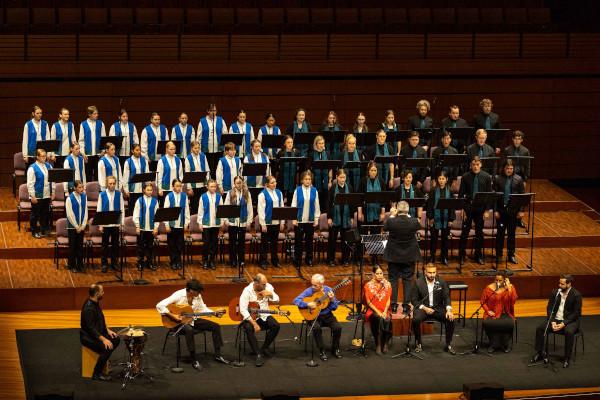In every field of the arts, there is one performer whose name is synonymous with the style.
For flamenco guitar, this is person is without doubt Paco Pena. Hailing from Andalusia, Spain, he has been playing, recording and educating in the style for well over 50 years.I saw him play in Melbourne in the 1990s when he toured with the swarthy Raul, one of the famous flamenco dancers, who sent hearts fluttering at the time. His music and shows traverse age groups, appealing across the board to those with a love of music and an open mind.
At 82 years old, he is still touring, and thankfully has endured the long trip to Australia to play an incredible piece of music he wrote over 20 years ago, 'Requiem For The Earth'. The piece is being played to lucky audiences in Brisbane and Adelaide, followed by a small number of concerts with the world-famous Australian Grigoryan Brothers.
Ahead of the tour, Pena gave an interview describing the nature of the music and the reasons for its existence. The name gives some insight in itself, however he talks of having earlier been asked to write a flamenco missa (mass), displaying a raw expression of flamenco guitar and singing, with the subtlety of a classical choir.
Following the popularity of this earlier piece, he was approached to write something further, along similar lines. After declining numerous times, he decided to take on this project, leading to the 'Requiem', which has religious input and a defined structure.
However, he hadn't decided on a theme until he clicked on climate change. Pena notes the music is not apocalyptic, but rather simply reflects on the beauty of the earth and the dangers which it faces.

Image © Bill Prendergast
The piece is optimistic, yet longs for a change in course. It is not hard to see how this piece and these thoughts may also apply to other upheaval in various parts of the world in our time. Importantly when he wrote it, Pena wanted a children's choir included in the arrangement to reflect their innocence in these matters.
The piece is intense, and Pena notes that on the day of a performance, he doesn't like to do anything unrelated to the performance. He notes that he is still learning, being willing to admit one has never completely mastered his craft.
It is sung in Latin and Spanish, but as is the case with a number of recent musical experiences, a complete and literal translation is not necessary to be impacted by the music and to understand what the writer and players are trying to reflect.
The Latin and Spanish would have created issues for the beautiful Voices of Birralee choirs (the Brisbane Birralee Voices junior choir and the Resonance of Birralee resident choir), who have spent two, three months rehearsing the piece, and only met the flamenco singers the day prior to the show for their first full day of final rehearsal.
The concert itself kicked off with the Spanish players surrounding Pena, the resident choir and conductor located behind, to be joined by the junior choir later in the show. The acoustics are of course flawless, and we are absorbed in a stunning evening of Spanish music.

Image © Bill Prendergast
I have been forewarned the opening 15 minutes is very solemn, and that is indeed the case. Pena leads the opening, playing a stunning solo introduction, his guitar ringing like a bell through the auditorium. He is slowly joined by the other two flamenco guitars, then the percussionist and the two female vocalists. The choir stands and when they join, it brings more of a religious feeling to the music.
Following the solemn introduction, the music becomes much more vibrant and uplifting, before another serious section. The more serious music alternates between a call and response from the male singers, followed by the equivalent with the females. The singers have exquisite voices, and the music is very passionate, and occasionally the non-leading male singer calls out in the background, as can be heard in most traditional flamenco music.
Forty-five minutes into the piece, the children's choir joins the stage for the first time, bringing a beautiful harmony to the music. A slower portion follows, with a very subtle syncopated clapping – another feature of flamenco music – before moving back into a much more rapid and elevated piece.
Another feature of the evening, and indeed a highlight, was the percussionist Julio Alcocer. Sitting on a kickbox (the cajon), he had the instrument on which he was seated, as well as a cymbal and a more sophisticated looking African drum. He used no drumsticks, but delivered a stunning percussive background to the music – extremely important for the style – and an amazing yet short solo piece.
The 'Requiem' wound up on a much more uplifting and apparently optimistic piece, and the syncopated clapping rose to an unbelievable pace in the crescendo. There were of course standing ovations, and a special applause for the percussionist and for Pena.

Image © Bill Prendergast
In promotion of the Adelaide show I read a great quote, which comes down to the effect this piece of music combines the solemnity of a requiem; remember a requiem is a piece of music to be played at a time of death – with the vibrant energy of flamenco. This is exactly what this evening delivered to me, and I think most of the crowd would have been similarly impacted.
In the interview alluded to earlier, Pena notes he want to be remembered for his honesty, a lack of gimmicks, noting "the music is my truth".
Whether it's playing on the renowned NPR Tiny Desk, onstage with famous guitarists and flamenco dancers, or in front of two choirs and a range of guitarists and singers as was the case this evening (9 September), there is no doubt whatsoever he will be absolutely remembered in this way. His energy shows he will be doing this for some years to come.
More photos from the concert.






